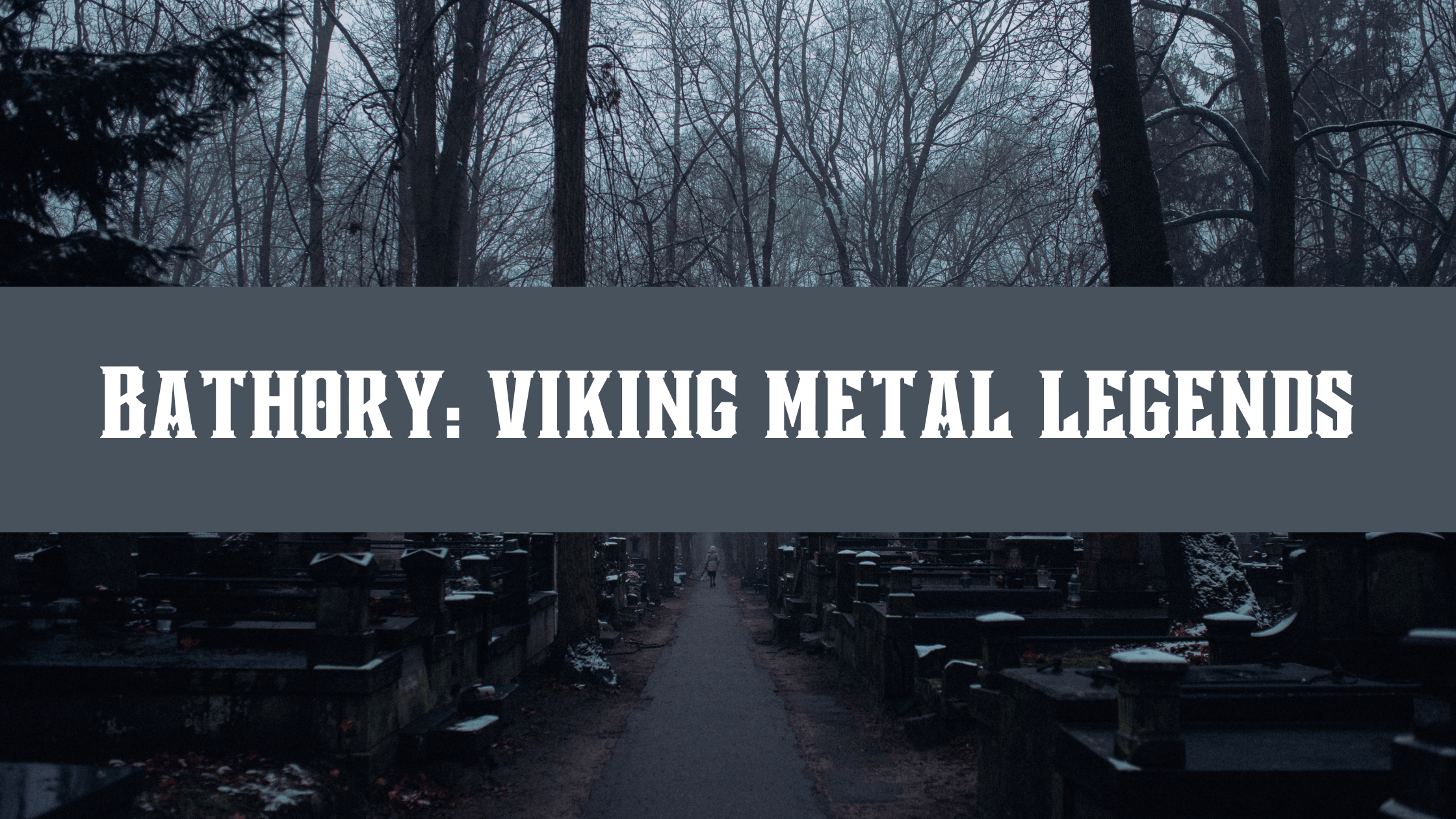In the annals of heavy metal history, there are bands that not only left an indelible mark on the genre but also pioneered new sonic territories. Bathory, hailing from Sweden, stands tall as one of these pioneering acts. Their visionary leader, Quorthon (Thomas Forsberg), took the reins of musical innovation and steered it towards uncharted waters. Bathory’s journey is a testament to their role as pioneers in both black metal and Viking metal.
Formation and Early Works
The genesis of Bathory occurred in the early 1980s in Sweden, a country that would soon become synonymous with metal excellence. Formed by the enigmatic Quorthon, Bathory set sail on a musical odyssey that would challenge conventions. Their early works, including the self-titled debut and “The Return,” laid the groundwork for a sound that would eventually encompass the grimness of black metal and the epic sagas of Viking lore.
Viking Black Metal Era
Bathory’s transformation into the pioneers of Viking black metal marked a significant turning point in their career. Albums like “Blood Fire Death” and “Hammerheart” were sonic manifestos that invoked the grandeur of Norse mythology and epic themes. Quorthon’s lyrical prowess and musical vision wove intricate tales of Viking conquests and ancient battles. This era saw Bathory emerging as the vanguard of a subgenre that would come to be known as Viking metal.
Influence on the Genre
The impact of Bathory on the metal genre, specifically on both black metal and Viking metal, cannot be overstated. Their pioneering spirit and willingness to push boundaries inspired countless bands to explore the realms of darkness and Viking heritage. Bands such as Amon Amarth, Enslaved, and Moonsorrow drew inspiration from Bathory’s music and thematic depth, further cementing their legacy in the metal pantheon.
Legacy and Quorthon’s Impact
Tragically, the metal world bid farewell to Quorthon in 2004, marking the end of an era. His untimely passing left a void in the metal community, but his legacy continues to shine brightly. Quorthon’s impact on the metal world transcends Bathory; he was a visionary who dared to dream beyond the confines of convention. His work, both with Bathory and as a solo artist, remains a source of inspiration for musicians and fans alike.
As we traverse the epic landscapes and delve into the grim soundscapes of Bathory’s discography, we unravel a band that not only pioneered new sonic frontiers but also left an enduring legacy in the realms of Viking and black metal. Bathory’s saga is a testament to the enduring power of music to transport us to distant shores and ancient battlefields.
Bathory’s Iconic Albums and Influential Songs
Bathory, the pioneering Swedish metal band, left an indelible mark on the world of heavy music. With their visionary leader, Quorthon, at the helm, Bathory released a series of groundbreaking albums and songs that would influence generations of metal musicians. Let’s delve into some of their most important and influential works.
“Bathory” (1984) – The Debut That Shaped Black Metal
Bathory’s self-titled debut album, released in 1984, laid the foundation for black metal. Songs like “Reaper” and “Sacrifice” showcased Quorthon’s raw and aggressive vocal delivery, while the guitar work introduced the tremolo-picked riffs that would become a hallmark of the genre. This album birthed a new era in metal, earning its place as one of the most influential releases in extreme music history.
“The Return……” (1985) – Ushering in the Darkness
In 1985, Bathory released their sophomore effort, “The Return……”. This album continued to shape the black metal landscape with tracks like “Total Destruction” and “Born for Burning.” Quorthon’s sinister lyrics and unholy shrieks added to the album’s dark mystique, cementing Bathory’s status as pioneers of extreme metal.
“Under the Sign of the Black Mark” (1987) – A Black Metal Masterpiece
“Under the Sign of the Black Mark,” released in 1987, is often regarded as one of the defining black metal albums. Songs like “Call from the Grave” and “Equimanthorn” showcased Bathory’s progression into more atmospheric and epic territories. Quorthon’s haunting vocals and the album’s chilling atmosphere left an indelible mark on the emerging black metal scene.
“Blood Fire Death” (1988) – Forging Viking Metal
As the ’80s drew to a close, Bathory underwent a transformation with “Blood Fire Death.” While still firmly rooted in black metal, this album introduced Viking metal elements. The song “A Fine Day to Die” is a testament to this shift, featuring epic melodies and lyrics inspired by Norse mythology. This album laid the groundwork for the Viking metal subgenre.
“Hammerheart” (1990) – Epic Viking Metal
“Hammerheart,” released in 1990, solidified Bathory’s venture into Viking metal. Songs like “Shores in Flames” and “One Rode to Asa Bay” featured majestic, folk-inspired melodies and lyrical tales of Viking sagas. This album is a genre-defining masterpiece that continues to inspire Viking metal bands to this day.
Bathory’s legacy extends far beyond their albums; their influence can be heard in countless black and Viking metal acts that followed in their footsteps. Quorthon’s vision and musical innovation forever changed the landscape of metal, and their iconic albums and songs remain a testament to their enduring impact on the world of heavy music.
“Twilight of the Gods” (1991) – Continuing the Viking Saga
Following the success of “Hammerheart,” Bathory released “Twilight of the Gods” in 1991. This album continued the Viking metal narrative with epic tracks like “Through Blood by Thunder” and “Blood and Iron.” Quorthon’s songwriting prowess and penchant for storytelling remained evident, solidifying Bathory’s place as Viking metal pioneers.
“Requiem” (1994) – Returning to Black Metal Roots
In 1994, Bathory returned to their black metal roots with “Requiem.” This album featured a more aggressive and raw sound reminiscent of their early work. Tracks like “War Machine” and “Pax Vobiscum” demonstrated a return to their black metal origins while retaining elements of their Viking metal exploration.
“Octagon” (1995) – A Bold Departure
With “Octagon,” Bathory took a bold departure from their previous styles. Released in 1995, this album delved into a more thrash and hardcore-influenced sound. While it received mixed reactions from fans and critics, it showcased Quorthon’s willingness to experiment and push musical boundaries.
“Blood on Ice” (1996) – An Unearthed Viking Gem
“Blood on Ice” was a previously unreleased album recorded in the late ’80s but not officially released until 1996. It continued Bathory’s Viking metal journey with tracks like “The Stallion” and “The Lake.” This album served as a testament to Quorthon’s dedication to crafting epic Viking tales.
“Destroyer of Worlds” (2001) – An Apocalyptic Concept
Released in 2001, “Destroyer of Worlds” featured a concept inspired by apocalyptic themes. Songs like “Lake of Fire” and “Death from Above” explored dark and foreboding narratives, showcasing Bathory’s ability to adapt and evolve their sound.
“Nordland I & II” (2002) – Viking Metal Epics
In their final studio albums, “Nordland I” and “Nordland II,” released in 2002, Bathory returned to their Viking metal roots. These albums featured grandiose compositions like “Viking” and “Foreverdark Woods,” offering a majestic and epic conclusion to their discography.
Bathory’s discography is a testament to Quorthon’s musical exploration and innovation. From their pioneering black metal roots to their influential Viking metal era and experimental phases, Bathory’s albums reveal a band that constantly pushed the boundaries of heavy music. Their enduring legacy continues to inspire a diverse range of metal subgenres and remains a cornerstone of extreme music.

